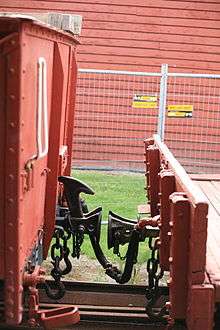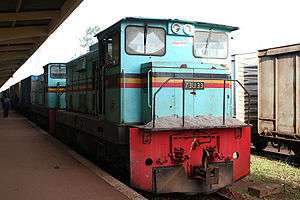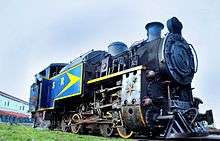Norwegian coupling




A Norwegian coupling (or meat chopper) is a manual coupling consisting of a central buffer with a mechanical hook that drops into a slot in the central buffer.[1] The system is only found on narrow gauge railways of 1,067 mm (3 ft 6 in) or less, such as Western Australian Government Railways, the Ffestiniog Railway and the Welsh Highland Railway, where low speeds and reduced train loads allow a simpler system. Norwegian couplings are not particularly strong, and may be supplemented by auxiliary chains. Not all Norwegian couplings are compatible with one another as they vary in height and width, and may or may not be limited to one hook at a time. The Norwegian coupling was developed in Norway around 1870, when the main domestic railway net was built to 1,067 mm (3 ft 6 in) narrow gauge. Later, during the 20th century, these lines were rebuilt into 1,435 mm (4 ft 8 1⁄2 in) standard gauge or closed. This meant that the rolling stock needed to be replaced, and buffers and chain coupler got used instead. Only museum railways, such as Setesdalsbanen and Urskog–Høland Line, use it in Norway nowadays. The New Zealand Government Railways, during the 1970s, developed an extremely large and heavy-duty version of the chopper coupler. These were first applied to a fleet of General Electric locomotives (U26C class DX), which had arrived from the United States with auto couplers. However, they were converted once it was decided that these locomotives would operate on other than just the North Island Main Trunk express freight trains.
On railway lines where rolling stock always points the same way, the mechanical hook may be provided only on one end of each wagon. This was the situation on the Lynton & Barnstaple (L&B), a narrow gauge line in Devon, England, and still applies to railways in New Zealand and on the Isle of Man Railway. Similarly, the hand brake handles may also be on one side of the wagons only. The L&B originally used side chains in conjunction with Norwegian couplers, but these were found to be unnecessary with the slow speeds employed (15–25 km/h or 9–16 mph) and were removed within a year or so of the line opening in 1898. The Isle of Man Railway still couples its side chains in operation today.
Kenyan railways, Uganda Railways, Tanzanian Railways and Mountain Railways of India also use the Norwegian coupler.
The Pichi Richi Railway in South Australia uses Norwegian couplers as its standard, and converts Janney coupler to Norwegian as required. The slot in the "buffer beam" where the coupler protrudes appears to be about the same for both types of couplers. As a museum, it is appropriate to use the older type of coupling.
